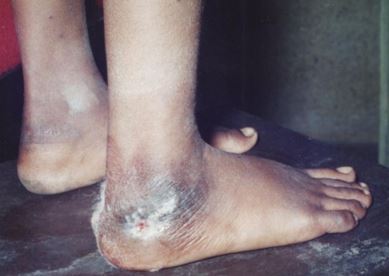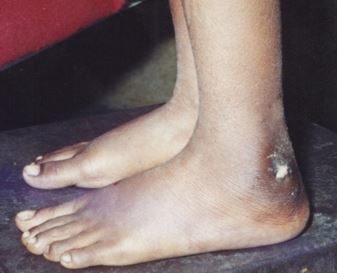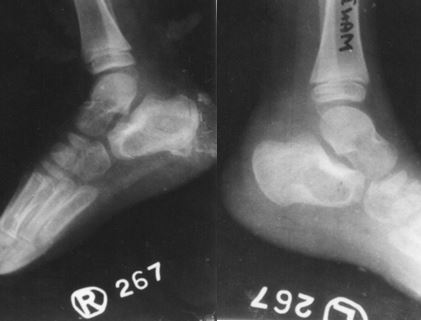Introduction
Tuberculous osteomyelitis of calcaneum is a very rare entity and has been very scarcely reported. The stress on study of calcaneal tuberculosis has also been diluted by the fact that most of the times tuberculosis of tarsals involves more than one bone and joints of the region. Thus, its awareness is low and diagnosis is often delayed. Furthermore, tuberculosis of the calcaneum is debilitating if untreated and delayed treatment may lead to functional disability.
Case Report
A six year old male child presented with complaints of pain, swelling and discharging sinus at both heels for duration of four months. It was associated with mild fever. Child had previously been evaluated at Primary health centre and Incision and Drainage was done on the right side. While the incision healed, a sinus remained at the distal most part of incision. Patient developed a sinus on left side later, and was referred to this hospital for non-healing sinuses. His parents did not give history of treatment of tuberculosis and had no family history of tuberculosis. The boy had received routine vaccinations including BCG.
On Examination, patient had swelling of both the heels for four months and discharging sinuses over both heels for three months. Swelling involving the heel region, was initially for one and half months, was associated with pain which later subsided. He had history of night sweats, evening rise of temperature in initial one month. No history of loss of weight or systemic illness was given by the parents.
Physical examination revealed temperature 97.40F, pulse 108/min., respiratory rate – 24/min. He had mild pallor. His body weight was 15 kgs. His inguinal lymph nodes were enlarged on both sides. Both feet had swelling in the heel region with sinus placed at posterolateral aspect with minimal discharge of serosanguinous fluid. Swelling was diffuse over both heels more on the lateral and posterior aspects, below and behind the lateral malleoli on both sides, of size about 5 cm. x 3 cm. x 1 cm. with skin discolouration due to increased pigmentation.

Figure 1: Clinical Picture Right Heel

Figure 2: Clinical Picture Left Heel
Sinuses were of size about ½ x ½ cm. with no active discharge but a minimal soakage. The sinuses were present about 1 cm. below and behind the lateral malleolus on left side while 2 cm. below and behind lateral malleolus on right side (Figure 1 & 2). On the right side it was present over the distal most and of an oblique healed incision of previous operation.
Sinus had their edges undermined, some granulation tissue over right side. The skin around the sinuses was excoriated and showed hyperpigmentation.Movements of both ankles were free while inversion was restricted and eversion absent.
Radiographs revealed central osteolytic lesions in both calcanei of size about 1 and ½ cm. x 1 cm. (Figure 3), with marginal sclerosis and osteoporosis of whole calcanei.

Figure 3: X ray of Both Heel
Laboratory data included, haemoglobin 10 gm%, total leukocyte count 9,600/mm3 with 62% polymorphonuclear cells, 36% lymphocytes and 2 % eosinophils. His ESR was 5mm at one hour and his urinalysis was normal.Biopsy taken through both sinus tracts with the help of a thin curette revealed tuberculous lesion.





